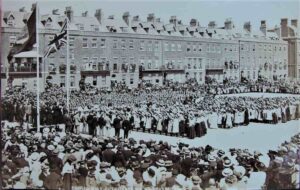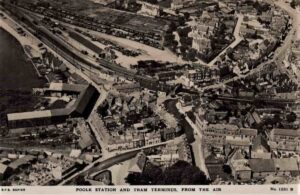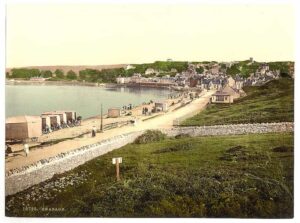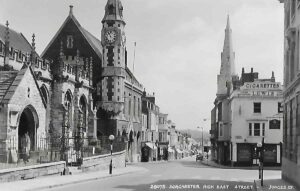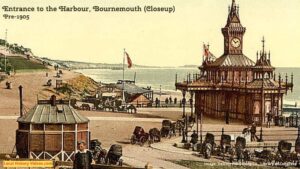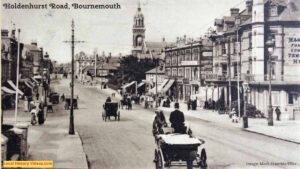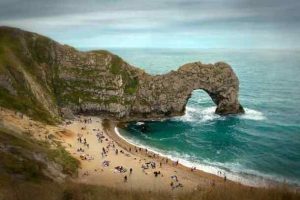Glimpse history through old images of Weymouth, Dorset, England.
Old Photos of Weymouth
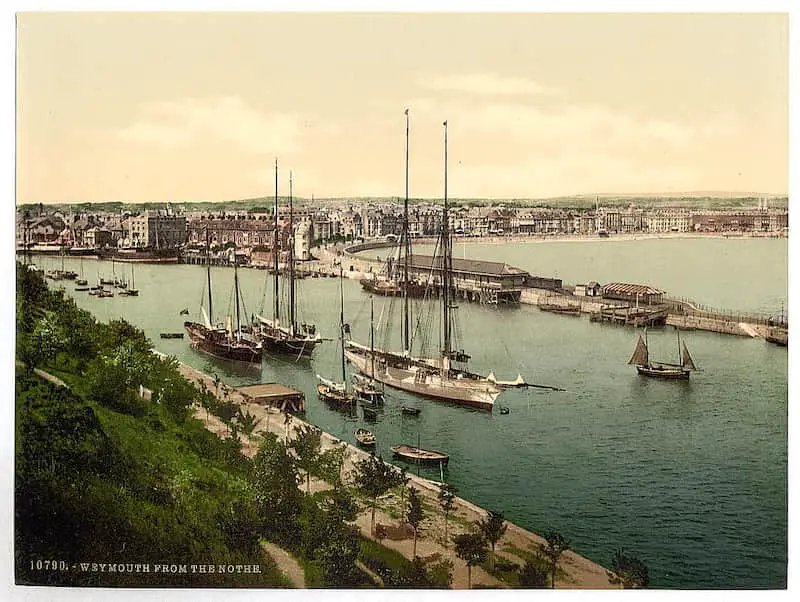
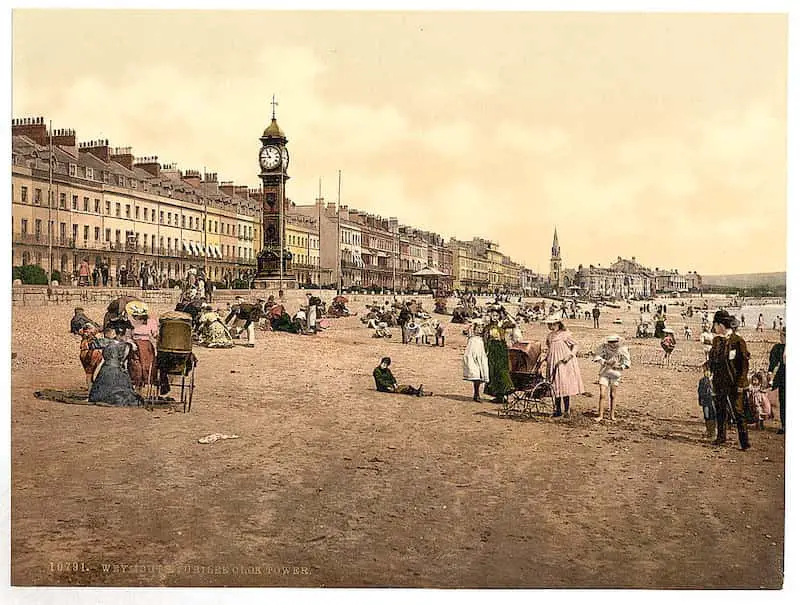
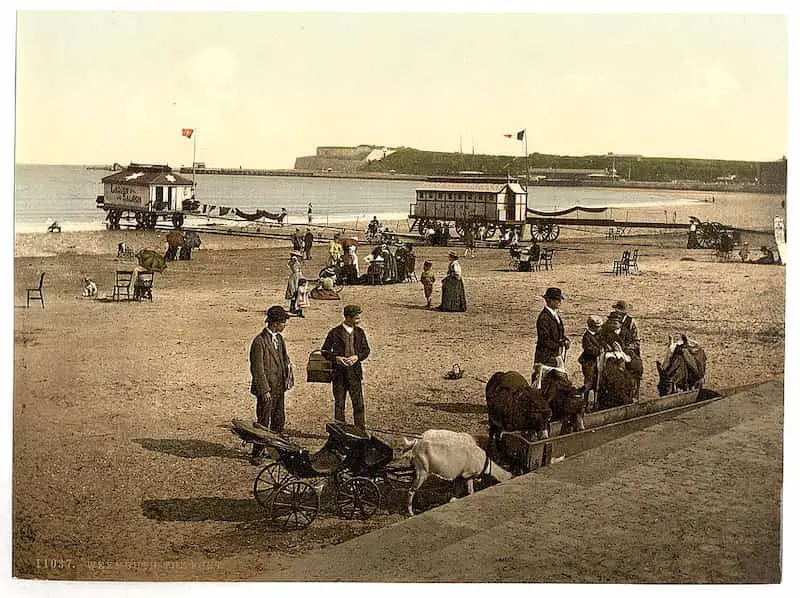
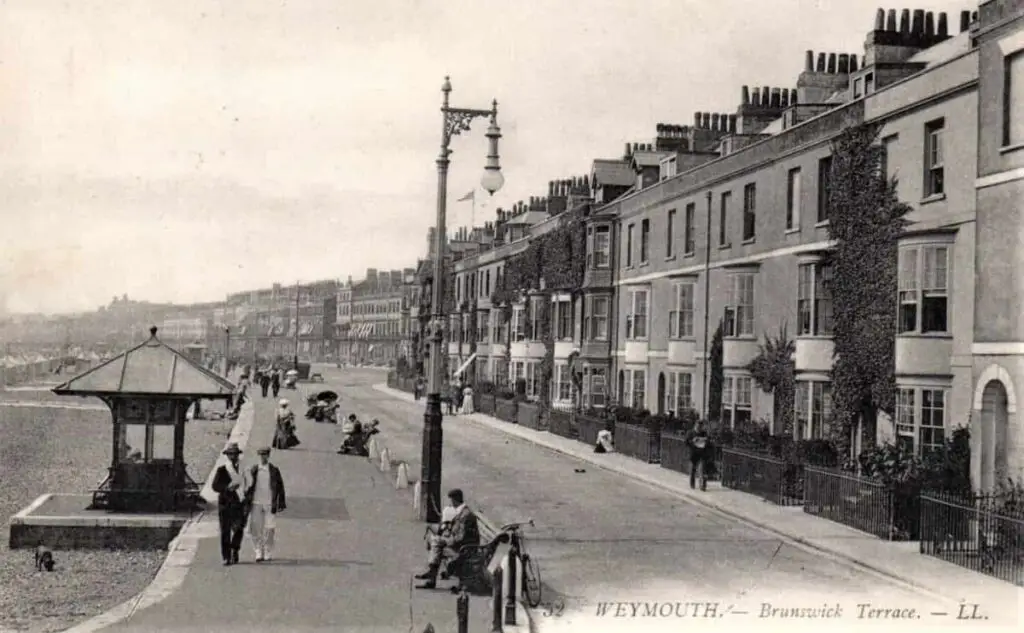
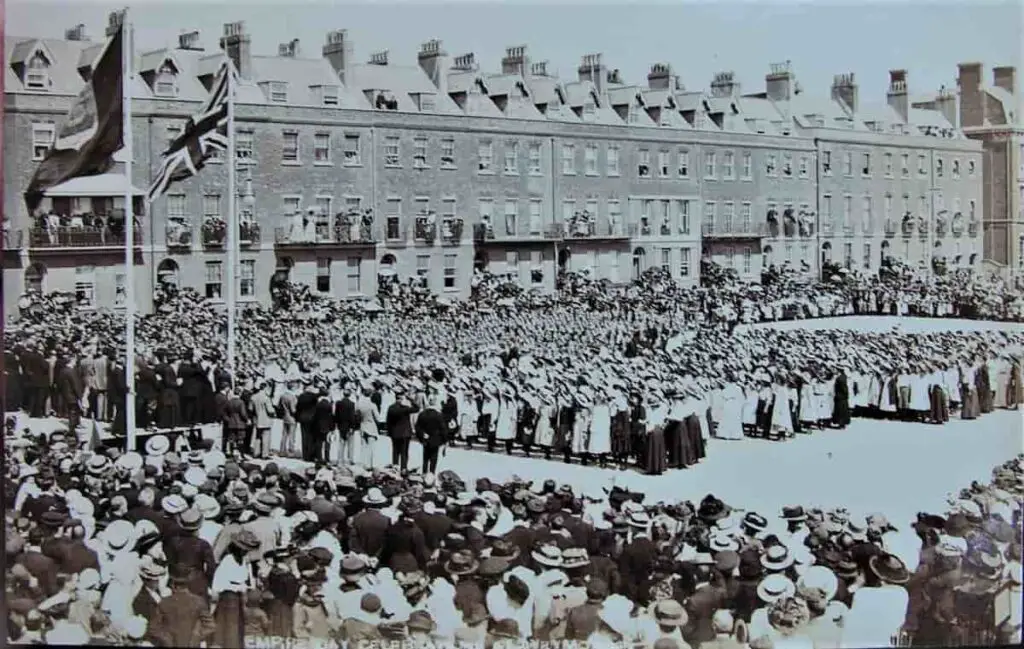
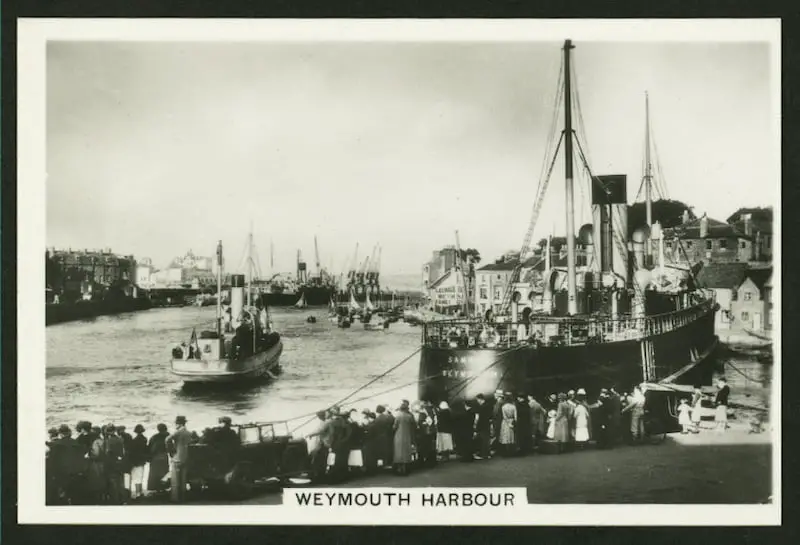
Weymouth Beach in 1964
In the summer of 1964, the beach was filmed packed with families enjoying the sand and sunshine. Donkey rides and even a sand sculptor were there to provide entertainment.
Includes glimpes of some of the properties lining the seafront.
Sand Artist (1964) – British Pathé on YouTube
Weymouth in 1986
Weymouth: Once Round the Bay (1986) – Sarah Limm on YouTube
A Bit of Weymouth History
Extract:
Post office [afterw.] Kelly’s directory of Hampshire, Dorsetshire, Wiltshire (the Isle of Wight, and the Channel Islands).
by Kelly’s Directories
Published in 1880
Pages 958 – 959
Weymouth and Melcombe Regis are parishes which form a seaport, parliamentary, and market town, the whole being usually known as Weymouth. Weymouth is the more ancient borough of the two, although Melcombe Regis appears to have enjoyed more privileges. Between these towns arose a great controversy; both enjoying like privileges, and both challenging the particular immunities of the haven; each of them having overthrown the other, they continually commenced new suits; at last, having wearied the Lords of the Council with their importunities, by the advice of William Cecil, the Lord Treasurer of England, they were, by an Act of Parliament, passed the 13th year of the reign of Elizabeth, amalgamated. Melcombe Regis is situated on the northern side of the harbour and takes its name from an old mill which formerly existed here; the second part, Regis, from its being part of a royal domain. In the Norman Survey, no mention is made of this place; it being then included in the parish of Radipole.
This town is situated on the English Channel, at the western side of a beautiful and expansive bay, which forms a semicircle, making a sweep of upwards of miles, sheltered by a range of hills to the north and the Isle of Portland to the south.
The site of the town is supposed to have been known to the Romans: its existence in the time of the Saxons is undoubted; and in the time of Edward III, it became a place of consequence. During the civil wars, it fell alternately into the hands of the King and the Parliament; subsequently to this period it sank gradually into decay and was merely an inconsiderable fishing town, till it began to acquire celebrity as a fashionable bathing-place.
Its beautiful situation and convenience for sea-bathing having attracted the attention of a gentleman from Bath, he recommended it to his friends and acquaintances. The Duke of Gloucester afterward visited it, and in 1789 George III. and his family made it their summer residence, and having experienced great benefit from its air and sea-bathing, frequently honored it with their presence. From these circumstances, the reputation of the town was completely restored, and in a few years, it was rebuilt and enlarged to meet the demands of its distinguished visitors.
The Esplanade is a handsome terrace, fronting the sea, about a mile in length and defended from the sea by a stone barrier: from this, the descent to the sands is easy, and the declivity is so gradual that at 400 feet from the shore, the water is not more than knee-deep: benches and seats are placed at convenient distances for the accommodation of invalids, who may sit and enjoy the sea-breeze, with a view of the extensive headlands to the east and the English Channel and the Bill of Portland to the south.
The town is well built, paved and lighted with gas, and well supplied with water and has a police force, consisting of a superintendent, two sergeants, and thirteen men. The principal houses front the sea; the streets in the town are very narrow and of great antiquity.
By the Municipal Reform Act, it is divided into two wards, governed by six aldermen and eighteen councillors, from whom the mayor is chosen: it formerly returned four members of Parliament but now only returns two: the electors are the old constituency and freeholders and £10 householders; the mayor is the returning officer.
The borough includes the parishes of Weymouth and Melcombe Regis and parts of the parishes of Wyke Regis and Radipole.
The church of St. Mary, Melcombe Regis, rebuilt in 1617, is a plain building, capable of seating 2,300 persons: it has a chancel, nave, and aisles and galleries: in the chancel is a beautiful altar-piece, The Last Supper, painted by Sir James Thornhill and one of his best efforts; he for some years represented this borough in Parliament: the church contains a fine organ, erected by subscription, and has a full choir. The register dates from the year 1560. The living is a rectory, with Radipole annexed, yearly value £305 with residence, in the gift of the Rev. Edmund Hollond and held by the Rev. Talbot Aden Ley Greaves M.A. of St. John’s College, Cambridge, who is also a surrogate.
Christ Church is a chapel of ease to St. Mary and was built in 1874 by public subscription: it is in the Gothic style, and has a chancel, nave, aisles, and a peal of 10 bells which chime every three hours, and were the gift of H. Edwards esq. M.P. for the borough.
Holy Trinity is an ecclesiastical parish, formed in 1830 from the parishes of Weymouth and Wyke Regis; the church is a plain building without a tower, consisting of chancel, nave, north aisle, and two galleries: in the chancel is a beautiful painting, by Vandyke, of The Crucifixion: it has an organ and full choir, and was opened for divine service in 1836, having been erected at the sole charge of the late Rev. George Chamberlaine, of Wyke Regis. The register dates from the year 1836. The living is a vicarage, in the gift of the Bishop of Salisbury and held by the Rev. Jebt Dupré Addison 3.A. of Exeter College, Oxford. The area is 205 acres; the population in 1871 was 5,007.
St. John’s is an ecclesiastical parish, formed in 1853 from the parishes of Melcombe Regis and Radipole; the church is Gothic, consisting of a chancel, nave, aisles, and transepts, with a spire: it has a fine organ and several stained windows and will seat 950, and was opened for divine service in October 1854. The register dates from the year 1854. The living is a vicarage, yearly value £300, in the gift of the rector of Melcombe Regis and held by the Rev. John Stephenson M.A. of Caius College, Cambridge.
There is a handsome Congregational chapel in Gloucester street, designed by R. C. Bennett esq. The Baptist chapel is in Bank buildings; the Wesleyan chapel is a commodious structure in Maiden street; there is a small Wesleyan chapel in the Park; the Hope Congregational chapel, in Trinity street; the Primitive Methodists’ in St. Leonards road; the Catholic chapel in Dorchester road.
A Cemetery was formed in 1850, about a mile west or north-west from the town, to facilitate the approach to which a bridge was constructed across the backwater: it comprises about four acres and contains two mortuary chapels.
A Port Sanitary Authority has been established, and a hospital is now (1880) in the course of erection at Wyke Regis at a cost of £5,000.
Many legacies have been left for the purposes of education; there are several societies for clothing the poor, charitable institutions, and benevolent societies.
The Guildhall, in St. Edmund street, is a handsome building of Portland stone with a fine facade and lofty pillars, containing a public hall, magistrates’ room, police station, and lock-up.
The general Market House is in St. Mary street; it is a commodious building, with a very handsome front; attached is a small fish market; the market is held on Tuesday and Friday and is well supplied with meat and vegetables.
The prosperity of the place depends mainly on its visitors, and since the railways have been extended to the town, increased numbers of persons have visited it.
The exports are Portland stone, bricks, tiles, and corn; the imports are coals, timber, and wines. Ship and boat building, sail and rope making, and brewing are carried on.
A yacht club was formed in 1875, called the Royal Dorset Yacht Club, and the Lords of the Admiralty have granted permission to fly the blue ensign of her Majesty’s Fleet, as also a burgee with the distinguishing marks of the club thereon – a blue cross with red edge and a crown in the center on a white ground: their Royal Highnesses the Prince of Wales and the Duke of Connaught K.G. joined the club as original members; the members now number 330, and about 150 of them belong to Dorset, including the Earl of Shaftesbury, the lord-lieutenant of the county; the united tonnage of their vessels amounts to over 12,000 tons.
A Life Boat was presented to the borough in 1809, by the Right Hon. the Earl of Stratford, through the Royal National Life Boat Institution.
The Masonic Hall, in Frederick place, is a chaste building, erected in 1826: it is in the Ionic style and contains an organ and all the necessary appliances for the order.
The Working Men’s Club in Mitchell street was built at the sole cost of H. Edwards esq., one of the members for the borough, and it is in the Romanesque style and contains a good library, lecture, and reading rooms.
The Royal Baths are situated in St. Mary and St. Thomas streets; the entrance is through a lofty corridor, on each side of which are arranged the baths and retiring rooms.
There are two public libraries and reading-rooms, containing an excellent collection of books and periodicals of the present day.
The Weymouth and Dorset County Royal Eye Infirmary was established in 1836: the present building was erected by public subscription in 1872: it is a Gothic building of Portland stone will make up twenty beds. Out-door patients are relieved on Sundays, Tuesdays, and Fridays from 8 a.m. to 10 a.m.
The Weymouth Royal Hospital and Dispensary were erected in 1872, and it is a substantial building, faced with red and black bricks. It will make up twenty beds, and out-patients are relieved every Tuesday and Friday.
The Weymouth Sanatorium, founded by W. J. Smith, M.D. in 1848, is for diseases of women and children.
Races are held here in August for the Queen’s plate, valued at 100 guineas, and other prizes.
The principal hotels are the Bardon Hotel in Victoria Terrace, the Royal Hotel, the Gloucester Hotel and Assembly Rooms in Gloucester Row, Victoria Hotel in Augusta Place, and the Crown Hotel in St. Thomas Street.
The rides and walks in the vicinity of Weymouth are very delightful and abound in beautiful scenery.
To the west of the town, on an eminence, is a place called the Nothe and Lookout; infantry barracks are also situated here. A Fort, in the shape of a horseshoe, stands on the cliffs, commanding the bay from the east side of the Nothe. It mounts 10 muzzle-loading rifled guns, 6 of which are 18 tons with a 10-inch bore, carrying a 400 lb. projectile, and four 12-ton, 9-inch bore guns carrying a 250 lb. projectile.
Farther along the cliffs are the ruins of Sandsfoot Castle, erected in the year 1533 by King Henry VII. It is situated at the edge of the cliff and is fast going to decay, with part of it having tumbled into the sea.
The population of the parliamentary and municipal borough in 1871 was 13,259; of Weymouth parish, 3,828; Melcombe Regis parish, 7,533; part of Radipole parish, 719; part of Wyke Regis parish, 1,179. The area of Weymouth parish is 77 acres, and of Melcombe Regis, 102 acres. The gross estimated rental of Melcombe Regis is £8,439, with a rateable value of £30,618. In Weymouth, the gross estimated rental is £8,807, and the rateable value is £7,900.
More Old Pictures of Weymouth
My Pinterest Board has more old pictures, vintage photos and other historic images of Weymouth’s past for you to share and enjoy.
https://www.pinterest.co.uk/LocalHistoryVideos/weymouth-in-old-photos-historic-pictures
More about Dorset
- Old Images of Weymouth, EnglandGlimpse history through old images of Weymouth, Dorset, England. Old Photos of Weymouth Weymouth Beach in 1964 In the summer of 1964, the beach was filmed packed with families enjoying the sand and sunshine. Donkey rides and even a sand sculptor were there to provide entertainment. Includes glimpes of some of the properties lining the… Read more: Old Images of Weymouth, England
- Old Images of Poole, DorsetGlimpse history through old images of Poole, in Dorset, England, UK.
- Old Images of Swanage, DorsetGlimpse history through old images of Swanage, in Dorset, England.
- Dorchester, England: History in Old ImagesEnjoy a glimpse of history through old images of Dorchester, in Dorset, England, UK.
- Old Images of Dorset, EnglandGlimpse history through old images of Dorset, England.
- Edward Craven Walker, Lava Lamp InventorDiscover how the inventor and filmmaker Edward Craven Walker came up with the idea for what became known as the Lava Lamp.
- Old Images of Bournemouth, DorsetEnjoy a glimpse of history through old images of Bournemouth, Dorset, England, UK.
- Dorset: Local History ResourcesPage Contents An Introduction To Dorset Cities In Dorset Towns And Villages In Dorset Dorset History Facebook Groups Dorset Local History Resources


